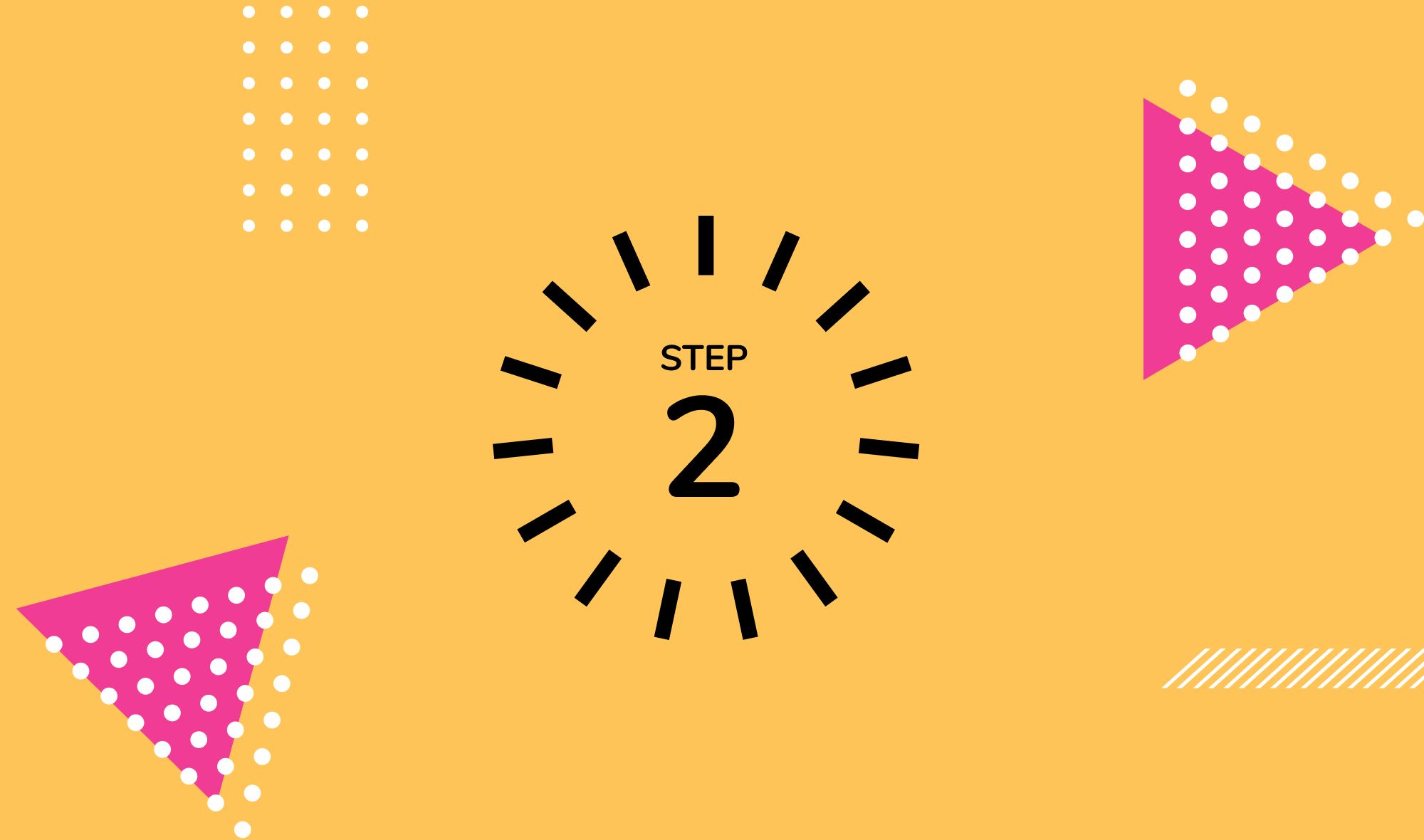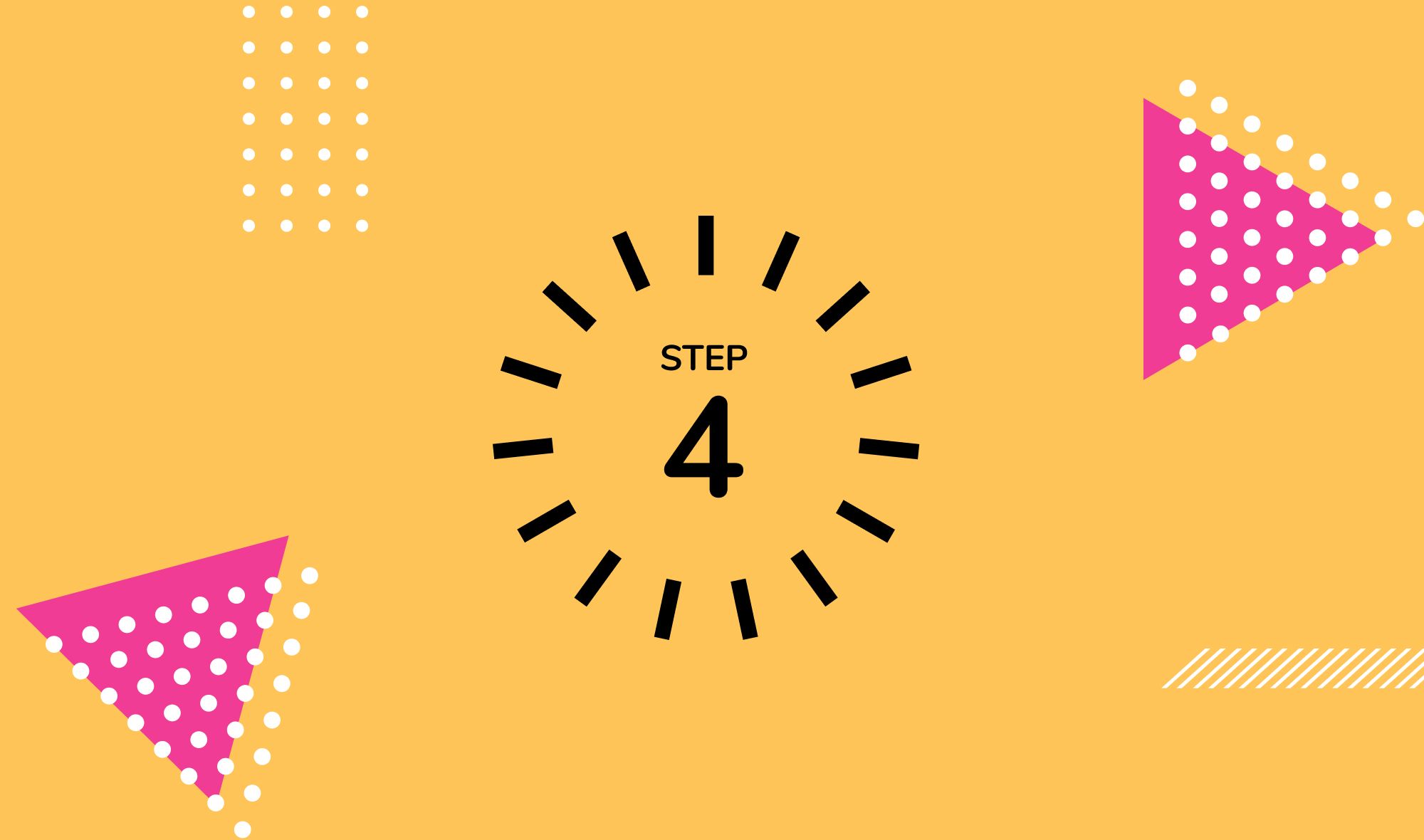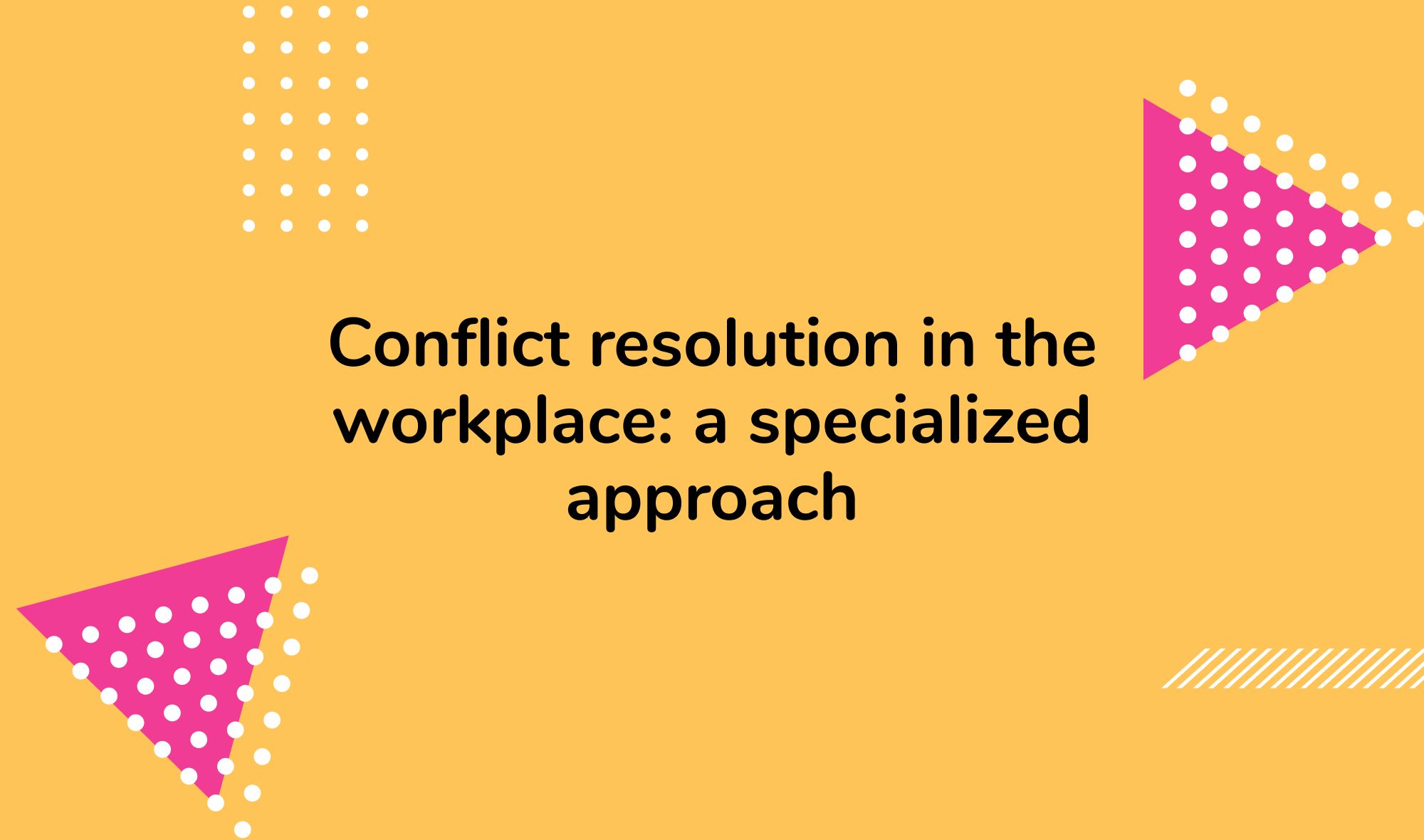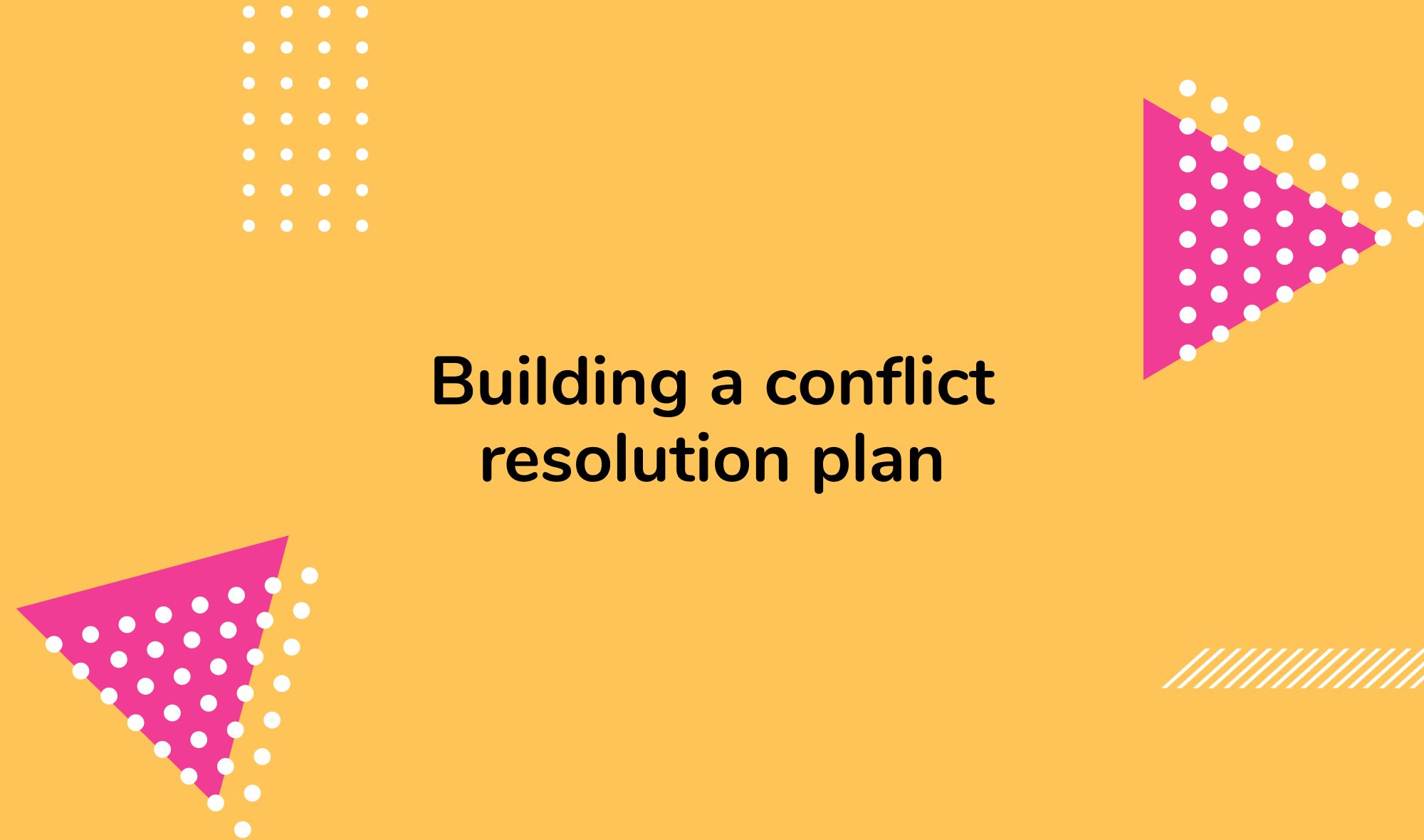Steps for conflict resolution: a 5-step pathway to peace
By Remy Meraz • June 5, 2023
Key Takeaways
- Conflict is inevitable but can be a catalyst for change.
- Identifying the root cause is the first step in resolving a conflict.
- Open, honest communication and empathy are crucial for understanding and resolving conflicts.
- Negotiation and reaching an agreement are final steps in conflict resolution.
- Conflict resolution skills are essential, especially in the workplace.

This post is part of our Conflicts resolution: your ultimate guide to peaceful interactions series. Check that out for more insights on the topic.
In our personal lives and workplaces alike, we encounter situations steeped in disagreement and conflicting interests. Navigating these waters can be challenging and often lead to tension or outright conflict. But what if we told you that conflict, often viewed with disdain, can become an opportunity for growth, learning, and strengthening relationships? Yes, the keyword here is 'conflict resolution.'
When harnessed effectively, conflict resolution strategies can transform a volatile situation into a conduit for positive change. How, you ask? By shifting the perspective from 'winning' to 'resolving.' By prioritizing mutual understanding and finding common ground. By focusing on the future, not just the present disagreement.
But this doesn't happen overnight, and it certainly doesn't happen without the right skills and knowledge. This is where we step in, offering guidance on how to resolve conflicts in the most effective manner. With an emphasis on the conflict resolution process, we'll explore how to identify the root cause, establish ground rules, encourage honest and effective communication, and navigate different personalities in a constructive conversation.
So, whether you're dealing with a workplace conflict or a personal one, let's dig deeper into the fascinating world of conflict management. Together, let's turn disputes into dialogues, contention into consensus, and obstacles into opportunities. Welcome to the 5-step pathway to peace!
Join our Newsletter
Transform your career with our personal growth insights. Get one valuable tip right in your inbox every Saturday morning.
Understanding conflict
The inevitability and potential value of conflict
Conflict is as inevitable as change, making it a universal phenomenon. Whether we're dealing with workplace dynamics, personal relationships, or even internal conflict, conflict finds us all. It arises from differences in interests, goals, or personalities. In its initial stages, conflict might seem like a hurdle, a discomforting roadblock disrupting our peace and status quo.
However, conflict is not always the villain it's made out to be. Indeed, the presence of conflict often signals the need for change and growth. It can stimulate innovative thinking, highlight underlying conflict sources, and promote deeper understanding between parties involved. When handled effectively, it can help us learn more about others and ourselves. Ultimately, conflict can pave the way for positive change, providing many benefits that we often overlook in the face of disagreement.
Principles of conflict resolution: going beyond the surface
Conflict resolution is much more than extinguishing a fire; it involves understanding the sparks that caused it in the first place. It requires us to dig deeper beneath the surface, to understand what each party truly wants and needs.
The first principle of conflict resolution is acknowledging that every party involved has a valid point of view. By accepting this, we can foster a space of mutual respect, laying the groundwork for effective conflict resolution. Another critical principle is open, honest communication. Misunderstandings often exacerbate conflict situations, and effective communication skills can help clarify intentions, reducing such misunderstandings.
Also, conflict resolution encourages us to identify solutions rather than blame, focusing on the issue at hand rather than the people involved. This approach ensures that all conflicting parties understand that the goal is not to win an argument, but to find common ground and a resolution that respects everyone's interests.
Lastly, conflict resolution encourages an approach that maintains relationships rather than damaging them. By setting ground rules for how to handle conflict, we can ensure that respect and understanding underpin our interactions, even when opinions differ. This principle takes us to such a place where resolution becomes a bridge, not a wedge, preserving the relationship for the future.
By following these principles, we can turn conflict from a dreaded foe into a catalyst for change, progress, and enhanced understanding. Remember, resolving conflict doesn't always mean eliminating differences; it often means learning how to manage them effectively.
The first step in conflict resolution: identifying the issue

It's often said that you can't solve a problem unless you know what the problem is. In conflict resolution, the first step is to do just that: identify the root cause of the conflict. This may seem straightforward, but conflict is often layered, with surface disagreements masking deeper issues.
Deciphering the real problem involves taking the time to explore all the concerns of the parties involved. It requires asking probing questions, actively listening to responses, and observing not only what is being said but how it's being said. As much information as possible must be gathered about the situation, from all involved parties, to paint a comprehensive picture of the conflict.
Deciphering what the real problem is
This process involves peeling back layers of the conflict, going beyond symptoms, and understanding the underlying causes. Are the conflicting parties fighting over a shared resource, or is the dispute rooted in differing values or personalities? Does the conflict stem from miscommunication or unmet expectations? The answers to these questions help illuminate the true nature of the dispute.
Understanding the root cause of the conflict provides a solid foundation for addressing the issue effectively. It also ensures that solutions target the true cause of the dispute, not just the visible symptoms. Without this step, conflict resolution efforts may fail to provide long-term solutions, causing the conflict to resurface in the future.
In this stage, it's also important for conflicting parties to understand that identifying the issue isn't about assigning blame. Instead, it's about understanding what is driving the conflict, allowing for a constructive, solution-oriented approach to resolution.
By accurately identifying the issue, we can ensure that subsequent steps in the conflict resolution process address the actual problem, leading to an effective and sustainable resolution. Remember, the goal is not to win, but to resolve and learn from the conflict. The first step to getting there is by identifying the real problem.
Conflict resolution strategies: open communication

Once we have identified the root cause of the conflict, the next stage of the conflict resolution process commences: communication. Effective communication is a cornerstone of conflict resolution strategies. However, this isn't just about speaking our minds; it's about ensuring that our messages are received and understood in the way we intended.
Clear, respectful dialogue aids in breaking down barriers between conflicting parties. It fosters an environment where all parties feel heard, understood, and valued. Furthermore, it allows us to express our concerns and expectations openly, reducing the likelihood of misinterpretations that might exacerbate the conflict. Open communication also enables parties to dig deeper into the perspectives of others, paving the way for mutual understanding and respect.
Steps to ensure efficient communication
Effective communication in conflict resolution involves several steps. First, it requires setting ground rules for the conversation. This may include allowing each party equal time to speak, agreeing to avoid interrupting each other, or committing to stick to the topic at hand.
Second, being an active listener is crucial. This means not only hearing the words the other party is saying but also understanding their underlying feelings and concerns. Active listening involves displaying empathy, acknowledging the other person's feelings, and asking clarifying questions when needed.
Third, it's essential to communicate with respect and patience. This involves using a calm and respectful tone, avoiding blame, and focusing on the problem, not the person. Such a respectful conversation environment can help reduce defensiveness and open the way for more honest communication.
Finally, effective communication requires clarity and directness. It's important to be clear about your concerns, needs, and the solutions you see to the conflict. Being direct and honest can help avoid misunderstandings and ensure that all parties have as much information as possible to work towards a resolution.
Implementing these steps can significantly improve communication during conflict resolution, leading to more fruitful conversations and effective solutions. And remember, conflict resolution isn't a debate to be won, but a problem to be solved - and communication is a key tool in reaching that resolution.
Third step to resolve conflict: seeking understanding

After identifying the problem and establishing open lines of communication, the third step in the conflict resolution process is to seek understanding. Understanding here isn't about agreeing with the other party or changing your stance to align with theirs. It's about developing a genuine comprehension of their perspective, their feelings, and the reasons behind their actions or position. This is where empathy plays a pivotal role in the conflict resolution process.
The power of empathy in the conflict resolution process
Empathy is the ability to put oneself in another person's shoes, to understand their feelings and perspectives. In conflict situations, empathy can be transformative. It helps us see past our own viewpoint and grasp the side's outlook we're in conflict with. When we empathize with the other party, we acknowledge their feelings and experiences, making them more likely to do the same for us.
Expressing empathy doesn't mean we agree with the other party or condone their actions. It simply means we understand their feelings or perspective. This mutual understanding can reduce tension, ease defensiveness, and open up new avenues for dialogue.
One effective way to foster empathy is through reflective listening. This involves paraphrasing what the other person has said to ensure we've understood correctly and express empathy for their feelings. For example, one might say, "What I'm hearing is that you felt overlooked when... Is that correct?" This technique allows for clarification, ensures that the other person feels heard, and shows that we are trying to understand their perspective.
When empathy becomes a part of the conflict resolution process, it aids in fostering mutual understanding between the opposing parties. This common ground becomes a fertile field where resolution can grow. Through understanding and empathy, we can transform conflict from a tug of war into a collaborative problem-solving process.
The art of negotiation: working towards a resolution

Once we've identified the issue, established open communication, and sought understanding, it's time to move into negotiation - the step where we start working towards resolving the conflict. This is where conflict management skills truly come into play, as the goal here is to find a solution that addresses the concerns of all conflicting parties involved.
Effective conflict resolution isn't about winning an argument but finding a win-win solution that respects and satisfies everyone's needs. The aim is to shift the paradigm from one of opposition to one of cooperation, creating a place where everyone feels heard, valued, and satisfied with the outcome.
Tactics and techniques for finding a middle ground
Finding a middle ground can be a challenging task, especially when the conflicting parties have different personalities, interests, or goals. Here are a few tactics and techniques to help in this process:
- Focus on interests, not positions: It's common for parties to stick to their initial positions during a conflict. However, understanding each party's underlying interests—what they really care about—can help identify solutions that meet everyone's needs.
- Identify and brainstorm possible solutions: Once the interests of all parties have been established, the next step is to identify potential solutions. Encourage all parties involved to suggest ways to meet these interests. This is a creative process, so encourage a wide range of suggestions without judgment.
- Evaluate solutions: After a list of potential solutions has been created, it's time to evaluate them. Each solution should be assessed based on its feasibility, the extent to which it meets the interests of all parties, and whether it can prevent future conflicts.
- Seek a win-win solution: The ultimate goal in conflict resolution is to find a solution that satisfies all parties. This is often a compromise - not a loss, but a mutual gain. In seeking this kind of solution, we're not just resolving the present conflict but also building stronger relationships for future interactions.
- Formulate a resolution plan: Once a solution has been agreed upon, it's important to formulate a plan detailing who will do what, when, and how. This plan should be clear, specific, and agreed upon by all parties involved.
The art of negotiation in conflict resolution is about transforming the situation from a battleground into a meeting ground. It's about turning a disagreement into an opportunity for growth, learning, and improved relationships. The process may be complex and challenging, but the benefits of effective conflict resolution are undeniable. It not only resolves the present conflict but also equips individuals with the skills and understanding to better handle conflict in the future.
Final steps for conflict resolution: agreement and follow-up

The final steps in our conflict resolution process are about reaching an agreement and ensuring a follow-up. These steps might seem simple, but they're pivotal in ensuring effective conflict resolution and preventing the recurrence of similar issues in the future.
The importance of consensus
An agreement in conflict resolution isn't just about settling on a decision. It's about reaching a consensus that all parties involved can genuinely support. This is where the win-win solution we've been aiming for comes into play. The goal is not to have one party conceding to the demands of the other but to find a solution that addresses everyone's needs and concerns.
Remember, it's important for each party to feel that the agreement is fair and that their needs have been considered. This consensus not only resolves the current conflict but also helps build trust and respect among the parties, improving future interactions and the overall relationship.
Checking in post-resolution
Follow-up is an often overlooked but essential part of the conflict resolution process. After an agreement has been reached and the conflict resolution plan has been implemented, it's beneficial to have a check-in or review. This allows the parties involved to reflect on the conflict, the resolution process, and assess the effectiveness of the solution.
Did the solution work as expected? Are the parties involved satisfied with the outcome? Have new conflicts arisen? This follow-up discussion provides a platform for addressing these questions. It helps to ensure that the agreement is working and that any new or recurring issues are promptly addressed. Moreover, it serves as a learning opportunity to improve conflict management skills and the conflict resolution process for future disputes.
Reaching an agreement and following up might be the final steps in the conflict resolution process, but they're crucial for ensuring a lasting resolution. They not only resolve the present conflict but also pave the way for healthier, more effective communication and relationships in the future. The result is a more harmonious and productive workplace, where conflicts are viewed not as problems, but as opportunities for growth and improvement.
Conflict resolution in the workplace: a specialized approach

Workplace conflict is a common occurrence given the mix of different personalities, roles, and interests. It's crucial to remember that while conflict is natural, letting it escalate unchecked can lead to reduced productivity, increased stress, and a negative work environment. Hence, effective conflict resolution is an essential skill for maintaining a healthy, productive workspace.
The good news is that the steps for conflict resolution we've explored so far can be tailored to professional scenarios. With a few adjustments to accommodate the unique characteristics and demands of a workplace, these steps can be a useful guide for resolving workplace conflicts effectively.
Tailoring the 5 steps to conflict resolution for professional scenarios
Let's take a look at how we can adapt these steps for workplace conflict resolution:
- Identifying the issue: In a professional setting, conflicts may arise from various sources - miscommunication, workload disputes, personality clashes, and more. It's essential to get to the root cause and understand the underlying conflict sources.
- Open communication: Encouraging open and honest communication is crucial in a workplace. This involves not only verbal conversations but also written communications, like emails, where miscommunications often occur. Maintaining professionalism and respect during these communications is vital.
- Seeking understanding: In the workplace, understanding each other's roles, responsibilities, and pressures can help conflicting parties understand each other's perspectives better and empathize.
- Negotiation: Negotiating in the workplace may involve additional factors like company policies or involvement of a neutral party like a manager or HR representative. The goal remains the same: finding a mutually beneficial solution.
- Agreement and follow-up: In a professional context, this might involve formalizing the agreement in writing and setting up regular check-ins to ensure the resolution is effective.
Remember, every workplace is different, and there's no one-size-fits-all solution. You might need to tweak these steps based on your organization's culture, the nature of the conflict, and the parties involved. However, the principle of conflict resolution remains the same - fostering understanding, finding common ground, and working collaboratively towards a resolution.
Whether you're a manager trying to mediate a dispute between team members or an employee involved in a conflict, these steps can guide you in resolving conflicts effectively. Not only will this result in a more harmonious workplace but also a more productive and positive one.
If interested in learning more about how cultural conflict can impact your workplace, check out Breaking barriers: addressing cultural conflict in the modern workplace.
For more on workplace conflict, conflict resolution in the workplace, managing conflict at the workplace check out:
Building a conflict resolution plan: a template for future disputes

Having a conflict resolution plan in place is a proactive way to handle conflicts. Instead of reacting to disputes as they arise, a plan allows you to have a clear strategy for conflict management. This strategic approach can reduce the stress associated with conflict, lead to faster and more effective resolutions, and prevent minor disagreements from escalating into major disputes.
How to prepare for potential conflicts proactively
Here's a simple guide to creating your own conflict resolution plan, which can serve as a template for future disputes:
- Establish clear communication channels: The first step in your plan should be to determine how conflicts should be reported and who should be involved in the resolution process. Clear communication channels help ensure that conflicts are addressed promptly and efficiently.
- Set ground rules: Agree on a set of ground rules that everyone should follow during the conflict resolution process. This might include maintaining respect for all parties, allowing equal time for each person to speak, and committing to honest communication.
- Choose a conflict resolution style: Refer to established models, like the Thomas Kilmann model, to understand different conflict styles and choose the one that best fits your organization's culture and the nature of the conflicts you typically face.
- Develop a step-by-step process: Based on the 5-step conflict resolution model we've discussed, develop a clear, step-by-step process for resolving conflicts. This should include identifying the issue, promoting open communication, seeking understanding, negotiating, and reaching an agreement.
- Plan for follow-up: After a conflict has been resolved, schedule a follow-up to assess the effectiveness of the resolution and address any recurring issues or new conflicts that may have arisen.
- Invest in conflict resolution training: Encourage all members of your organization to develop their conflict resolution skills. This could be through workshops, seminars, or regular team-building exercises that involve problem-solving and negotiation.
Remember, the goal of your conflict resolution plan is not to avoid conflict but to handle it in an effective manner that turns potential obstacles into opportunities for growth and improvement. By preparing for potential conflicts proactively, you're equipping yourself and your team with the tools needed to maintain a positive and productive environment, regardless of the challenges that come your way.
For more on strategies for conflict resolution and steps for conflict resolution, check out Strategies for conflict resolution: an essential guide to maintaining peace. If you're interested in learning more about effective meetings and how to make them productive, check out our blog post on Is That Truly an Important Meeting? A Quick Guide to Effective Meetings.
Conclusion: The journey towards effective conflict resolution
Conflict is inevitable, in the workplace and elsewhere. But with the right approach, it needn't be destructive. Instead, it can serve as a catalyst for change, improvement, and mutual understanding. Through recognizing the true nature of conflict, identifying the root cause, promoting open and honest communication, seeking understanding, negotiating, and reaching an agreement, we can turn potentially destructive situations into opportunities for growth.
The steps for conflict resolution outlined in this post are not merely a formula to be followed blindly, but a guiding framework that can be adapted and applied in various situations. As we grow in our conflict resolution skills and understanding, we will be better equipped to handle the disagreements that arise and transform them into beneficial discussions.
The ability to effectively manage and resolve conflict is a vital leadership skill, one that extends far beyond the workplace. From resolving disputes among team members to navigating personal relationships, these strategies for conflict resolution can help maintain harmony and foster a more productive and respectful environment.
Remember, at the heart of conflict resolution lies the principle of empathy. By stepping into the shoes of the other party, we can better understand their perspective, paving the way for a resolution that respects the interests of all parties involved.
In the end, conflict resolution isn't about winning or losing—it's about understanding, compromise, and finding a solution that works for everyone. By embracing conflict as an integral part of human interaction and a potential force for positive change, we can navigate the choppy waters of disagreement with grace, understanding, and confidence. The path to peace is often paved with conflict, and with the right tools, we can turn this path into a journey of growth and mutual understanding.
Dive in nurturing your mind, body, and soul, we invite you to explore our blog post on Executive Presence: The One Leadership Quality No One Told You About.
If you are interested in training in conflict resolution and mastering the art of dispute resolution, check out:
If you're interested in nurturing your mind, body, and soul, we invite you to explore our blog post on 45 Self-Reflection Questions that can provide valuable insights and support your personal growth journey.
Read more about: Conflict Resolution
About Remy Meraz
Remy Meraz, co-founder, and CEO of Zella Life, is a visionary leader who leveraged corporate glass ceiling challenges as a woman of color to drive systemic change.
While leading and cultivating high-performance teams from VC-backed startups to Fortune 500, she consistently faced obstacles such as inadequate mentorship, lack of psychological safety, and non-personalized training. Taking matters into her own hands, she turned to executive coaching and NLP training. This life-changing growth experience led to breaking leadership barriers and a passion for cognitive psychology.
Motivated by her experiences, she co-founded Zella Life, an innovative AI-driven coaching platform bridging the talent development gap by enhancing soft skills and emotional intelligence (EQ) in the workplace.
Her vision with Zella Life is to transform professional development into an inclusive and impactful journey, focused on the distinct needs of both individuals and organizations. She aims to promote advancement and culture change by ensuring every professional's growth is acknowledged and supported.
Today, Remy is recognized as an influential innovator, trainer, mentor, and business leader. Under her leadership, Zella Life has delivered significant measurable outcomes for numerous well-known brands. This track record of positive outcomes garnered attention and funding from Google for Startups and Pledge LA, establishing Zella Life as a pivotal force in the learning and development arena tackling and resolving fundamental talent development issues for organizations of all sizes.